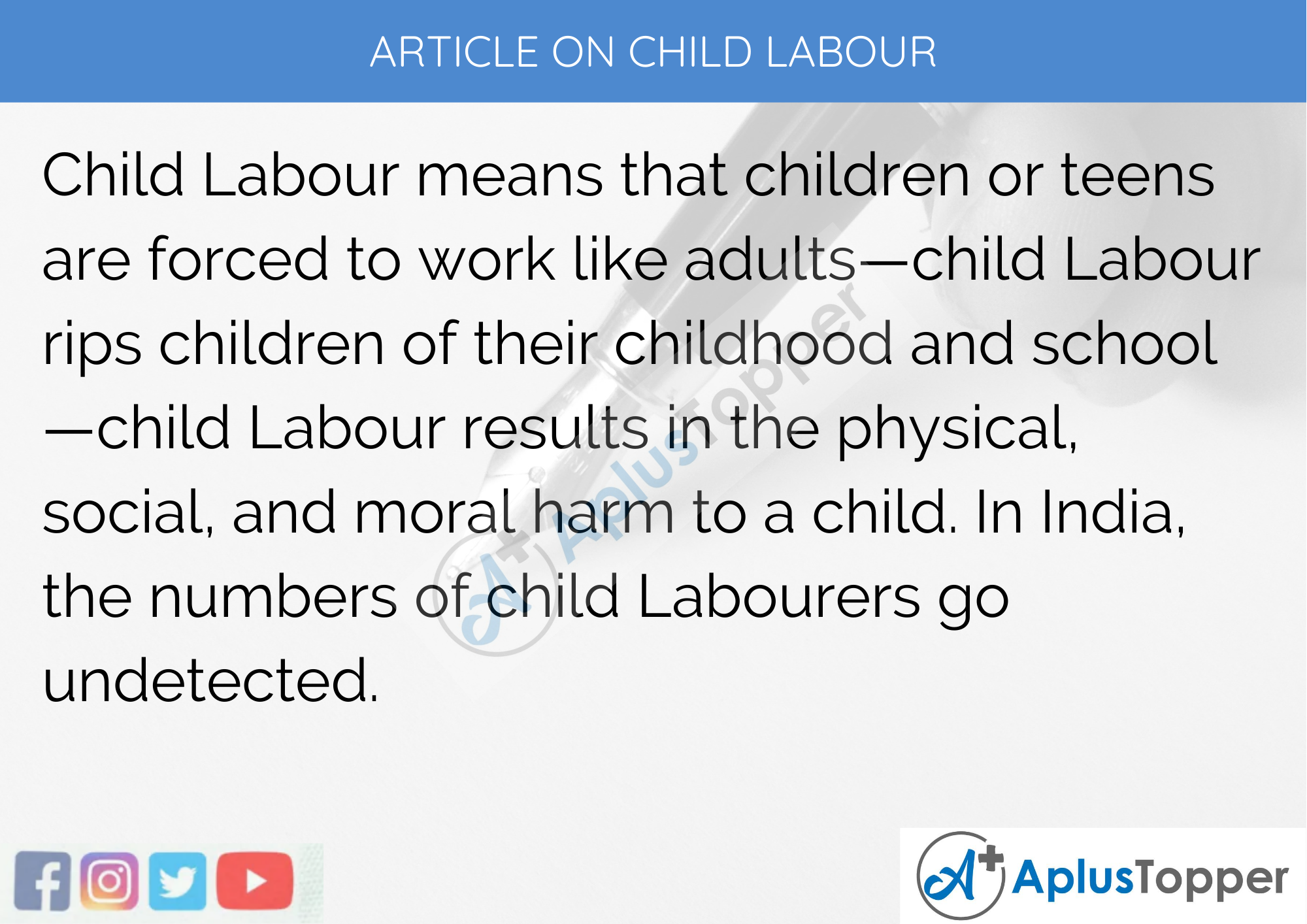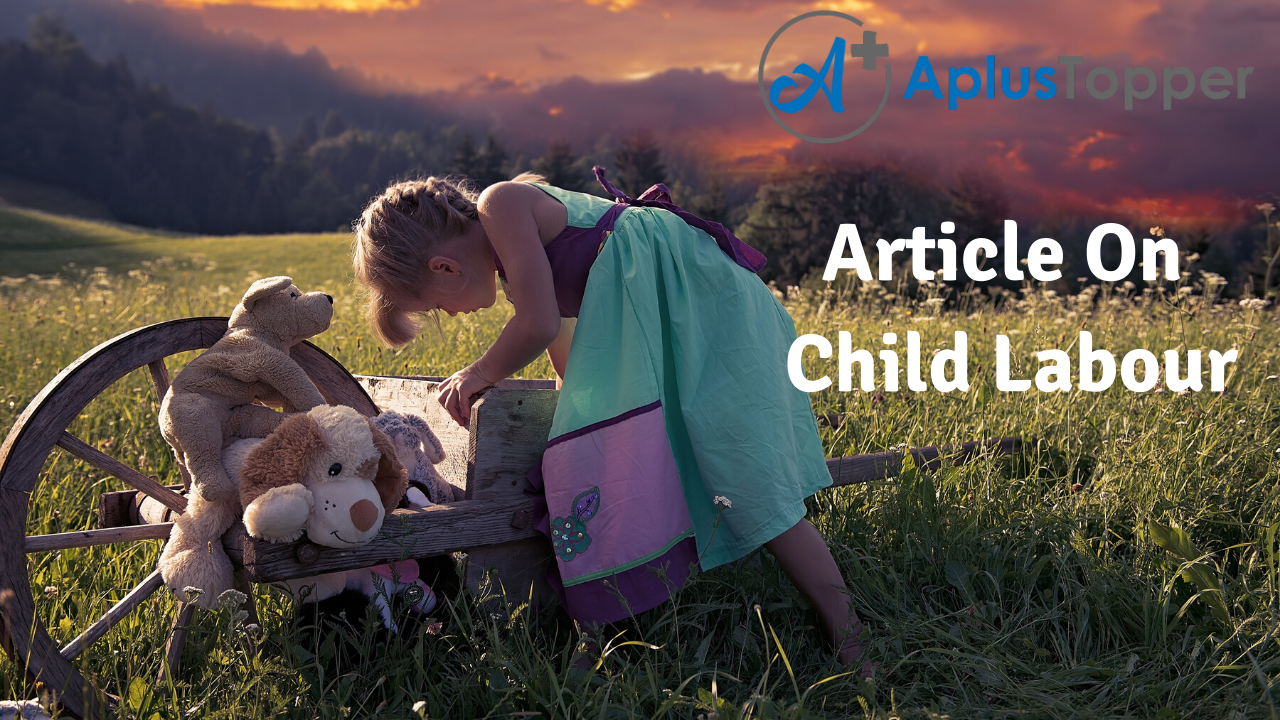Article on Child Labour: Child Labour occurs when children are forced to take up work at an age they need to study and enjoy the phase of innocence. Child Labour leads to the loss of childhood and escalates the exploitation of children in various forms.
India faces situations where children are forced to work under adverse conditions. Despite Laws against Child Labour, many children remain exploited as cheap Labour as the authorities are unable to implement strict laws and actions to protect children. Society and law-makers must eradicate child Labour in India.
You can read more Article Writing about people, sports, technology many more.
Long and Short Articles on Child Labour for Students and Children in English
We have provided two types of articles on Child Labour– a 500 words Long article and a 200 words Short Article. The Long Article on Child Labour consists of 400-500 words. The Long Article provides a framework that helps students with their competitive exams, assignments, article writing, debate, etc. The short essay on Child Labour is written for 200 words and is suitable for children and kids with their classwork.

Long Article on Child Labour 500 Words in English
Given below is a Long Article on Child Labour for aspirants of competitive exams and students belonging to classes 6,7,8,9, and 10. The Child Labour article helps the students with their class assignments, comprehension tasks, article writing, debate, and even competitive examinations.
In India, children are forced to work illegally in multiple industries. However, Agriculture is the largest sector that employs children to contribute to the family income. Indian rural sectors employ 85 percent of children due to various social factors that fail to meet their lifestyle.
Despite constitutional provisions to abolish Child Labour, many children remain exploited under hazardous work conditions. Due to paid Labour, children abandon their studies to support their families. They are made to forego all the wonders of childhood by the ruthless world.
Causes of Child Labour
The leading causes of Child Labour in India are social inequality, lack of education, and poverty. According to UNICEF’s report, children from the impoverished and rural parts of the world have no available alternatives such as teachers and schools.
Many rural communities lack adequate school facilities and the availability of schools. The low paying economy blooms with low cost, easy to hire, and child Labour. Besides the unorganized Agricultural sector, child Labour exists in unorganized assembly, unorganized retail works, and unorganized trade sectors.
Other factors of child Labour include the size of the informal economy, the inability of most Indian industries to scale up, lack of modern technologies, and the structure and inflexibility of the Indian market.
Bonded child Labour
Children are employed due to social obligation, or loans and debts made by the families. Usually, children are forced to employ their families in brick kilns, stone and quarries, and agricultural sectors.
The children of the migrant workers and those that belong to the marginalized sections and Dalits in the society are pledged to work in small production houses and factories in the urban areas. Child Labourers on the bond are usually subjected to physical, emotional, mental, and sexual abuse, even leading to death.
In Orissa, the people of the lower section of the society sell their daughters belonging to eight to 10 years of age, as maidservants to the clear their debts.
Lack of implementation of Laws
The Child Labour (Prohibition and Regulation) Act, 1986, was the only enacted provision by the Indian Constitution against child Labour and its atrocities. Other provisions stated by the Indian Constitution are:
- Article 24 of the Indian Constitution states that no child below the age of fourteen shall employ in any hazardous employment or factory but not in non-hazardous industries.
- Article 39(f)) of the Indian Constitution states that children and young adults are to be protected against moral and material abandonment or any forms of exploitation.
Various other Laws and the Indian Penal Code, such as The Factories Act,1948, The Mines Act,1952, the Juvenile Justice (Care and Protection) of Children Act-2000, and the Child Labour (Prohibition and Abolition) Act-1986 seek to prevent the practice of child Labour in India.
Unfortunately, these laws and regulations lack active and proper implementation and enforcement.
Short Article on Child Labour 200 Words in English
The 200 words short Article on child labour mentioned below is suitable for kids and children of classes 1,2,3,4,5 and 6. The article is written to guide the children with their school works-assignments and comprehension exercises.
Child Labour means that children or teens are forced to work like adults—child Labour rips children of their childhood and school—child Labour results in the physical, social, and moral harm to a child.
In India, the numbers of child Labourers go undetected. Many children are forced to work in unregulated conditions without adequate wages, food, or even rest. Many become victims of physical, sexual, and emotional abuse.
The widespread problem of Child Labour:
Child Labour is quite relevant in India due to poor schooling opportunities and the country’s high poverty rate. Child Labour is relevant in both rural as well as urban regions of the country.
As per the 2011 census report, the total population of the age group between 5-14 years is 259.6 million in India. Almost 3.9 percent of the total child population that is 10.1 million children in the country work either as the primary worker or as a marginal worker.
Reports state that almost 40 percent of child Labour occurs in the field of precious stone cutting. Child Labour exists in industries such as zari and embroidery, mining, dhabas, restaurants, tea stalls, and even at homes as domestic Labour.
The civil authorities and organizations need to work in unison to free child Labour under extreme conditions.

10 Lines About Article on Child Labour
- Child Labour refers to the working of children and teens to earn a livelihood and support their family.
- As per a report, the world’s most destitute and impoverished countries comprise about 25% of children as child Labourers.
- The leading cause of child Labour in India is the high poverty rate, where children work to earn bread for a day.
- Child Labour is usually seen in the field of agricultural works, hunting, forestry, and fishing.
- Child Labour causes physical, mental, and even social strain and danger to children.
- Child Labour prevails due to cheap wages. Child Labour increases the profit of businesses in India.
- According to the 2011 Census report of India, almost 10.1 million children between the age of 5 years to 14 years work as child Labourers in India.
- UNICEF report on Child Labour in India states that the U.P. employs 2.1 million children, Bihar employs 1 million children, Rajasthan employs 0.84 million children. M.P. employs about 0.70, and Maharashtra employs 0.72 million children.
- International laws, such as the International Labour Organization, is set to eliminate child Labour.
- The Child Labour (Prohibition and Regulation) Act, 1986, states that children’s employment in any work is a criminal offense.
FAQ’s on Article on Child Labour
Question 1.
What is Child Labour?
Answer:
Child Labour means that children or teens are forced to work like adults—child Labour rips children of their childhood and school.
Question 2.
Which Law is implemented by the Indian Government to stop Child Labour?
Answer:
The Child Labour (Prohibition and Regulation) Act, 1986, states that children’s employment in any work is a criminal offense.
Question 3.
What is the child Labour rate in India?
Answer:
According to the 2011 Census report of India, almost 10.1 million children between 5 years to 14 years are employed as Labourers.
Question 4.
What is the reason behind the prevalence of Child Labour in India?
Answer:
The leading cause of child Labour is extreme poverty in India. To supplement their parents’ income or being the only wage earners in the family, children end up as Labourers in various industries.
